New DiscoveriesMary Ann Flaxman, Portrait of Eleanor Anne Porden, ca. 1811
by Maureen Warren and Virginia Brilliant
Maureen Warren
Krannert Art Museum, Champaign, IL
Email the author: maureen[at]illinois.edu
Virginia Brilliant
Director, Old Masters, Robilant+Voena, New York
Email the author: virginia[at]robilantvoena.com
Citation: Maureen Warren and Virginia Brilliant, “Mary Ann Flaxman, Portrait of Eleanor Anne Porden, ca. 1811,” Nineteenth-Century Art Worldwide 23, no. 1 (Spring 2024), https://doi.org/10.29411/ncaw.2024.23.1.7.
This work is licensed under a Creative Commons Attribution-NonCommercial 4.0 International License  unless otherwise noted.
unless otherwise noted.
Your browser will either open the file, download it to a folder, or display a dialog with options.
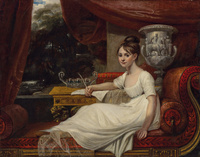
In 2022, Krannert Art Museum at the University of Illinois Urbana-Champaign in Champaign, acquired a remarkable portrait of the poet Eleanor Anne Porden (1795–1825) painted by Mary Ann Flaxman (1768–1833) (fig. 1).[1] Measuring 441⁄2 inches high and 565⁄8 inches wide (113 x 143.8 cm), it is the only identified example of a sizable oil painting by Flaxman, as the whereabouts of nearly all of her other documented works are unknown.[2] The portrait not only presents unique evidence of Flaxman’s abilities as a painter but, seen in conjunction with contemporaneous sources about the artist and poet, it also offers interesting insights into the shared social circle of Flaxman and her model and the ambitions and interests members of this friendship group shared. More broadly, the painting provides an opportunity to examine female engagement with the arts in Britain at the outset of the nineteenth century.
Acquired two years ago by Krannert Art Museum and already published in Paris Spies-Gans’s A Revolution on Canvas (2022) and in the Wikipedia article on Pordon, the painting does not strictly qualify as a “new discovery.”[3] Nonetheless, the importance of the work and its acquisition by a museum warrants an in-depth look at this fascinating portrait.
The Artist: Mary Ann Flaxman (1768–1833)
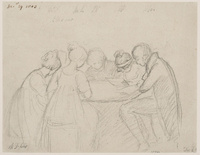
Little is known about Flaxman’s early life. She was born in 1768 and was the half-sister of the well-known sculptor John Flaxman (1755–1826), who gave her drawing lessons. She worked in a style Alexander Gilchrist described as “expressive and beautiful. . . . abound[ing] in grace of line, elegance of composition, and other artist-like virtues.”[4] Between 1786 and 1819, she exhibited painted and sculpted portraits and genre scenes at the Free Society of Artists, the Society of Artists, and the Royal Academy.[5] She was also active in London artistic circles, as evinced by a drawing depicting a congenial sketching party at the home of the engraver Wilson Lowry (1762–1824) in 1803 (fig. 2).[6] Such informal, often regular gatherings for the purpose of artistic study and critique, as shown in the drawing, were small nodules in a complex network of artists built around kinship and shared interests, bolstering a sense of collective identity and contributing to the professionalization of its members.[7]
Mary Ann Flaxman’s best-known works—illustrations for the 1803 edition of William Hayley’s (1745–1820) Triumphs of Temper, which were etched and engraved by William Blake (1757–1827)—are paradoxically the only ones her contemporaries deemed not entirely successful (fig. 3). Hayley’s mock-epic didactic poem was intended to teach young girls to become proper wives by advising them to control their tempers. The poet may have hoped Mary Ann’s designs—which her brother called “just and delicate”—would appeal to his predominantly female readership.[8] He had no such luck, complaining to John that women did not like the illustrations.[9] John defended his sister, admitting her designs were not perfect but insisting that Blake’s engravings were worse.[10]
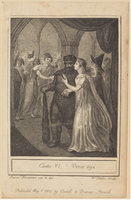
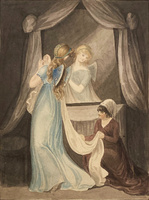
The stylistic mismatch between Flaxman and Blake becomes clear when juxtaposing their depictions of the book’s protagonist, Serena, dressed as Ariel from Shakespeare’s The Tempest. One is an autograph watercolor copy of a design by Flaxman that Hayley did not select for reproduction (fig. 4); the other is one of Blake’s prints after Flaxman’s lost designs (see fig. 3). Flaxman’s Serena has a lithe, neoclassical physique, with broad hips and long legs, and wears a gown the fabric of which both clings to reveal her body and falls in elegant folds. Blake’s print, on the other hand, looks overworked, with erratic and excessive linework that conflicts with the soft, serene atmosphere. The negative reception of the illustration must have been a major setback for Flaxman. She did not receive another commission for book illustrations until eight years later, when Mary Jane Goodwin (1768–1841) commissioned her to design illustrations for two children’s books by Charles Lamb (1775–1834).[11]
From 1804 to 1806, Flaxman was governess to the children of the peripatetic Georgina and Francis Hare-Naylor, an artist-and-writer couple. While living in Germany, Italy, and Switzerland, Mary Ann drew the local landscapes and inhabitants in her sketchbooks.[12] She also enlarged a copy of the Almanach de Lausanne to include a diary and sketches.[13] One notation from 1805 states that she “finish’d the portrait of Mr. H.”[14] She made other portraits during this period, including a miniature portrait at the Weimar court. In a letter to Georgiana Hare-Naylor, John Flaxman bragged that he expected his sister would spend the winter producing “such a collection of family portraits single figures & groups . . . as would shame Vandyke & put Titian to the blush.”[15] After returning to London, Mary Ann submitted her sketches made abroad to the exhibitions of various educational and exhibiting societies in an effort to gain public exposure, which perhaps she hoped could lead to greater critical acclaim and increased sales.[16] Petitioning the Associated Artists in Water-Colours (1807–12) for membership in 1809, she stated, “I have sent for the inspection of the Society two sketches of Peasants, which I made in Switzerland and three copies in Miniature after Raphael, G[u]ercino, and Rembrandt.”[17]
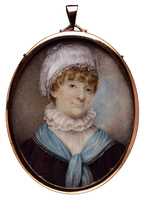
In 1810, Mary Ann joined John Flaxman’s household at 7 Buckingham Street, which included his wife Anne (née Denman) (1760–1820) and Anne’s sister Maria (1776–1861). The four formed a close-knit family and cultivated a circle of artistic and literary friends.[18] John’s drawings demonstrate their household’s warmth and conviviality, capturing Mary Ann playing chess with Anne or sewing with Maria.[19] A miniature thought to be a self-portrait of Mary Ann from this period, made when she was about fifty, shows a woman smiling serenely in a white, lace-edged mob cap and ruff collar and wearing a pale blue shawl over a purple dress (fig. 5). Mary Ann and Maria assisted John with his artistic practice until his death in 1826, when they relocated to 74 Upper Norton Street. The move signaled a decrease in size of the Flaxman family but not its dissolution, as friends such as the artist Eliza Aders still referred to Mary Ann and Maria as “the Flaxmans.”[20] After his death, John’s estate and debts fell to the two women.[21] Mary Ann lamented that, as women, they were not deemed worthy of continuing his business and could only content themselves with completing works he had left partially finished and publishing prints after his designs.[22] Seven years later, in 1833, Mary Ann died at age sixty-five, leaving her belongings to Maria and other friends and family.[23]
The Sitter: Eleanor Anne Porden
Eleanor Anne was the younger of the two surviving daughters of the distinguished architect William Porden.[24] From the age of fourteen, Eleanor not only nursed her invalid mother but also effectively ran her father’s house and became his chief companion, first in Devonshire Street and then in Berners Street, London. Educated under the direction of her father, Eleanor was not limited to a traditional female curriculum. She read widely in chemistry, geology, natural history, and botany, and regularly attended lectures by leading scientists at the Royal Institution in Albemarle Street.
Many of the subjects she encountered at the Royal Institution became themes in her writing. As she matured, Porden began to mingle with a distinguished literary, scientific, and artistic set in London, the inner circle of which, dubbed “the Attic Chest,” included all four Flaxmans.[25] Porden became hostess and “editress” for this informal literary society, which met during the winter from 1808 to 1815 and took its name from the Grecian cedarwood box that held the members’ original submissions—a box given by John Flaxman that may have been made from a shipping crate used to transport some of the Elgin marbles to London.[26] The Flaxmans and Pordens established a close, affectionate relationship at these gatherings, using nicknames for one another in their submissions and personal correspondence. The origin of Porden’s nickname—Stella—is unknown, but the Flaxmans’ aliases came from Shakespeare’s A Midsummer Night’s Dream. John and Anne Flaxman were King Oberon and Queen Titania and their sisters Mary Ann and Maria were named for the queen’s fairy entourage: Moth and Peachblossom, respectively.[27] Such was the closeness of their families that John Flaxman once jokingly referred to himself as Eleanor’s other father.[28]
On July 3, 1810, Eleanor Anne Porden shared a poem with the members of the Attic Chest entitled “The Rape of the Veil.”[29] Composed of short cantos, it became the basis for her epic poem The Veils, or The Triumph of Constancy, published by John Murray in 1815. In the latter, kings of the earth, sea, and fire steal the three female protagonists’ veils, which the kings use to cast a spell that will force the women to marry them if the veils are not recovered. After three knights are captured attempting to recover the veils, the three protagonists assume the quest themselves, ultimately using their scientific knowledge to rescue their men and reclaim their veils. British scholar Adeline Johns-Putra characterizes The Veils as a new genre—scientific romance—which imparts the author’s knowledge of chemical processes in an allegorical format in verse.[30]
Other epic poems followed The Veils, including The Arctic Expeditions (1818) and Coeur de Lion, or The Third Crusade (1822). The Arctic Expeditions was inspired by visits to HMS Alexander and HMS Isabella, then being equipped for polar exploration. Porden’s most ambitious work, Coeur de Lion, was published in sixteen cantos. It was inspired by bloody tales of medieval heroism and, according to Johns-Putra, “the fashion for Orientalist poetry set in the Near East (in the style of Lord Byron) and historical epic (as popularized by Robert Southey).”[31]
An especially lively correspondent who was said to have had many male admirers, Eleanor married Sir John Franklin (1786–1847), a naval officer and famous Arctic explorer, in 1823.[32] Independent in her thinking and confident of her talent, Eleanor made it a condition of their marriage that Franklin respect her career as a poet. She wrote in a letter of March 23, 1823: “It was the pleasure of Heaven to bestow those talents on me, and it was my father’s pride to cultivate them to the utmost of his power. I should therefore be guilty of a double dereliction of duty in abandoning their exercise.”[33]
Upon their marriage, the couple settled at 55 Devonshire Street, in the house in which Eleanor had been born. On June 3 1824, their daughter, also named Eleanor, was born. Porden never fully recovered from the birth; by the end of the year, she was diagnosed with tuberculosis; she died at her home on February 22, 1825, less than a week after Franklin embarked on his second Arctic expedition, carrying with him a Union Jack flag she had embroidered. It was raised at the northernmost point reached by the expedition, near the Déline Fishery at Great Bear Lake.[34]
The Portrait
Flaxman’s portrait beautifully captures Porden’s intellectual prowess as well as the vogue for classical design in Regency Britain. The young author is seated on an elegantly curved, red-upholstered chaise longue, her arm leaning upon a writing desk, quill in hand and poised above a sheet of writing paper. She wears a simple white muslin dress and is partially encircled by a transparent white polka-dotted veil with a border in a Greek-key design, looped casually over a blue-slippered foot. Atop the desk are two red, leather-bound volumes—perhaps containing the sitter’s own verse—and a boat-shaped sterling inkstand embellished with acanthus leaves and containing three glass pots of translucent, greenish-black ink. The table and chaise longue relate to pieces by Thomas Hope (1769–1831), the innovative and influential designer who helped define the Regency style. The table with its winged chimera supports closely resembles a design by Hope published in Household Furniture and Interior Decoration (fig. 6), while the chaise longue is an adaptation of a form found in the same volume (fig. 7). In A Revolution on Canvas, Spies-Gans cites this portrait for its adroit use of subtext and art historical reference: “By placing Porden on a Greek-style divan, Flaxman played with a visual trope that associated lounging on such classicized furniture with female sexuality and political power . . . [but Flaxman] defies—or adjusts—those stereotypes” by showing the poet sitting upright, ready to begin her work.[35] Thus, Flaxman shrewdly aligns Porden’s aptitudes and ambitions with the printed page rather than her influence on or relations with (male) partners.
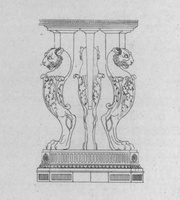
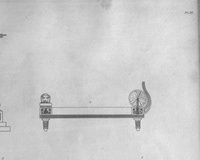
Behind the table, flanking the head of Porden, is a large marble garden vase. In form and decoration it closely resembles the famous Greco-Roman Medici Vase, many copies of which could be found in England in the early nineteenth century (fig. 8). However, the frieze running across its body is different, representing the sacrificial procession of a bull toward an altar, a subject found on another antique vase in the garden of the Kensington country manor known as Holland House, which was among the inspirations for the Romantic poet John Keats’s (1795–1821) “Ode on a Grecian Urn,” first published in 1819 (fig. 9). Keats’s poem may have resonated with the painter and her sitter, whose attraction to the budding Romanticism of their time is likewise reflected in the twilight view of a wooded landscape visible beyond the red-draped window of the stone portico or garden pavilion in which the model sits.
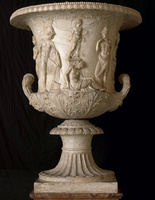
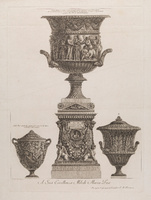
Circumstances and Date of the Portrait’s Creation
There are no records indicating when, why, and for whom the Portrait of Eleanor Porden was created. It is not mentioned in surviving correspondence and, although reproduced as the frontispiece for the biography of Porden written in 1930 by her grandson’s wife Edith Mary Gell (1860–1944), it is not discussed therein. There is reason to believe the painting was a friendship portrait. A twentieth-century inscription on the stretcher reads: “Eleanor Porden – poetess / 1st Wife of Sir John Franklin / reputed to be painted as a gift by Flaxman.” It is a reasonable supposition that a member of the Gell family wrote or provided this information based on oral history. Certainly, there is abundant evidence that Mary Ann and Eleanor developed an especially deep connection after the artist returned to London. In 1808, Flaxman—a well-traveled woman of forty—was one of six attendees whose poetry was read at the inaugural meeting of the Attic Chest, hosted by the then thirteen-year-old Porden. Flaxman would become one of the most active participants in Porden’s literary salon, contributing at least ninety-seven poems in meetings that took place from 1808 to 1817.[36] Additionally, the two women corresponded regularly until Eleanor’s death in 1825. In their witty and animated letters to one another they often used the sobriquets Moth (for Mary Ann) and Stella (for Eleanor).[37]
Speculating about the circumstances of the portrait’s creation is made more difficult by the fact that we do not know when it was painted. A Sotheby’s catalogue of 1989 and Spies-Gans in A Revolution on Canvas identify it as the portrait of Porden that Flaxman exhibited at the Royal Academy exhibition in 1811 (no. 645).[38] That date, if correct, would allow for an interesting possible explanation of one of Porden’s accessories in the painting. In 1810, the fifteen-year-old Eleanor shared an early version of her scientific romance The Veils with members of the Attic Chest.[39] The sheer, veil-like shawl on which Porden is seated, the ends of which are visible underneath the paper and quill and wound around her foot, might signal her excellence as a writer. As Johns-Putra explains, Porden demonstrated an intellect and influence at meetings of the Attic Chest that belied her years: “Although the circle consisted of older and not undistinguished guests—artists, writers, and politicians . . . Porden’s poetry seems to have dominated the society and she was herself the subject of many of its writings.”[40] Even prior to the publication of the much-expanded version of The Veils in 1815, members of the Attic Chest would have been privy to its significance. That genre-defying publication—and Porden’s first major work—had been inspired by the sight of the veil of Maria Denman (John’s Flaxman’s sister-in-law and Mary Ann’s close friend) blowing away while they collected shells on the coast of Norfolk.[41] Additionally, one of the three protagonists of The Veils, Maria, can be identified as Maria Denman.[42] As such, the veil in the portrait could have evoked not only Porden’s literary accomplishments but also the close, affectionate bonds between members of the Attic Chest, especially the Pordens and Flaxmans.
Some scholars have questioned whether this large portrait actually was Flaxman’s Royal Academy entry in 1811, as it was hung in the miniatures section of the exhibition. Full-size portraits were sometimes shown in that section, especially when they were produced by painters who also did miniatures. But it does seem strange that such a large portrait as Porden’s, measuring over four-and-a-half feet in width, would hang amid a display of much smaller paintings. However, since no miniature portrait of Porden by Flaxman is known, and the entry of 1811 is the only one referring to any portrait of Porden by Flaxman in the Royal Academy catalogues, it seems likely that it refers to the Krannert portrait.
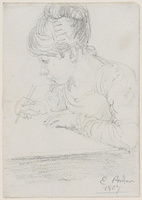
Though it supports the thesis that this portrait was included in the Royal Academy exhibition of 1811, the Sotheby’s catalogue of 1989 paradoxically identifies the books in Flaxman’s portrait as two volumes of Porden’s Coeur de Lion. That epic poem was published in 1822, when Porden was twenty-seven. But the painting more credibly depicts Porden in 1811, when she was sixteen, especially given its resemblance to a sketch of her at age twelve by John Flaxman (fig. 10).[43] John sketched Porden engrossed in her writing, with the same upswept hair and pen in hand as in the painting, the year before she formed the Attic Chest. His sister’s painting convincingly depicts Porden four years later, with the longer limbs, more angular features, and more sophisticated wardrobe befitting a young woman.
Maria Flaxman and Eleanor Anne Porden at Illinois
When the Porden’s only child, Eleanor Isabella Franklin (1824–60), married Rev. John Philip Gell (1816–98) in 1849, she took the portrait of her mother to Hopton Hall—the Gell family’s ancestral seat in Derbyshire—where it would hang for the next 140 years. When the estate left the Gell family’s hands in 1989, the portrait was sold by Sotheby’s.[44] It surfaced at auction three more times before being acquired by Krannert Art Museum in 2022.[45]
Flaxman’s portrait of Porden has found an apposite home at Krannert Art Museum. The University of Illinois’s Rare Book and Manuscript Library (RBML) possesses the edition of Hayley’s Triumphs of Temper in which Flaxman’s illustrations appear as well as the editions of Compositions from the Tragedies of Aeschylus and Compositions of the Acts of Mercy, both reproducing drawings by John Flaxman, that his sister and Maria Denman published in 1831. It also possesses a trove of materials related to Arctic exploration, much of it relating to Porden’s husband Franklin,[46] including a copy of his 1823 Narrative of a Journey to the Shores of the Polar Sea that he presented to Mary Stiven (first wife of Artic explorer John Richardson) with an uncollected version of a poem by Porden, which first appeared in a letter she wrote to Franklin the year before.[47] The most recent addition to the university’s RBML is a group of letters from the Porden and Gell families, including some from Eleanor and her father.[48]
After having been held in private collections since its creation, Mary Ann Flaxman’s portrait of Eleanor Anne Porden will now be publicly accessible at Krannert Art Museum. If Porden’s name had been known previously at the University of Illinois Urbana-Champaign, it would only have been in connection with her husband’s Arctic exploits. Flaxman’s portrait will bring Porden’s own accomplishments to the fore, as it will become a focus of teaching and research at the university. Similarly, it is hoped that Flaxman’s reputation will grow with the public exposure of her fascinating portrait. May this painting be the first of several works by Flaxman to reappear in public, and may our knowledge about the broader circle of creative women in which Flaxman and Porden worked thus be further reconstructed.
Acknowledgments
Thank you to David O’Brien for his comments on an earlier draft of this article.
Notes
[1] Mary Ann Flaxman has often been confused with Maria Denman, artist and sister-in-law of John Flaxman. As such, we do not refer to either woman here as “Maria Flaxman.”
[2] Extant works by Mary Ann Flaxman known to the authors but not otherwise discussed in this article include the undated red-chalk drawing Mythological Scene with Hermes and a Goddess (Fine Arts Museums of San Francisco); the etching Hygeia of ca. 1779, designed by Flaxman and etched by Harriet Wilkes (British Museum, London); and the watercolor Eastern Pursuits of 1786 (sold at Lyon & Turnbull, Edinburgh, on January 24, 2014, lot 77, for £625).
[3] Paris A. Spies-Gans, A Revolution on Canvas: The Rise of Women Artists in Britain and France, 1760–1830 (New Haven, CT: Paul Mellon Centre for Studies in British Art, Yale University, 2022), frontispiece, and 160–62, fig. 81; and “Eleanor Anne Porden,” Wikipedia, accessed January 17, 2024, https://en.wikipedia.org/wiki/Eleanor_Anne_Porden.
[4] Gilchrist had nearly finished Blake’s biography when he died in 1861. His wife Anne Gilchrist completed and published it two years later. Alexander Gilchrist, Life of William Blake, “Pictor Ignotus,” vol. 1 (London: Macmillan, 1863), 171–72.
[5] Among the more than seven hundred women who exhibited at the Royal Academy from 1769 to 1830, Flaxman is notable for having shown a total of twenty-seven works. Paris Spies-Gans, “1800: The Growing Presence of Female Exhibitors,” in The Royal Academy of Arts Summer Exhibition: A Chronicle, 1769–2018, ed. Mark Hallett, Sarah Victoria Turner, and Jessica Feather (London: Paul Mellon Centre for Studies in British Art, 2018), n.p., https://chronicle250.com/1800.
[6] Initials along the top of the drawing identify the participants as Maria Denman (an artist and John Flaxman’s sister-in-law); Elizabeth Mulready (a landscape painter and John Varley’s sister); Matilda Lowry (a watercolorist); John Varley (an artist and astrologer); an unidentified woman; and William Mulready (a genre painter and Varley’s brother-in-law and pupil).
[7] Greg Smith, “Establishing Professional Status and Identity, c. 1795–1824,” chap. 5 in The Emergence of the Professional Watercolourist: Contentions and Alliances in the Artistic Domain, 1760–1824 (Aldershot, UK: Ashgate, 2002), 177–227, esp. 182–83.
[8] John Flaxman to William Hayley, August 24, 1803, cited in Mark Crosby, “‘A Ladys Book’: Blake’s Engravings for Hayley’s The Triumphs of Temper,” in Blake in Our Time: Essays in Honour of G. E. Bentley, Jr., ed. Karen Mulhallen (Toronto: University of Toronto Press, 2010), 111–12.
[9] William Hayley to John Flaxman, August 7, 1803, cited in “William Hayley, The Triumphs of Temper (Composed 1803),” The William Blake Archive, accessed June 5, 2023, https://blakearchive.org/work/bb471. Regarding Blake’s “masculine” linearity in his reproductive prints, see Robert N. Essick, “William Blake’s ‘Female Will’ and Its Biographical Context,” Studies in English Literature, 1500–1900 31, no. 4 (Autumn 1991): 615–30, https://doi.org/10.2307/450820 [login required].
[10] Letter from John Flaxman to William Hayley, August 24, 1803, cited in Mark Crosby, “‘A Ladys Book:’ Blake’s Engravings for Hayley’s The Triumphs of Temper,” in Blake in Our Time. Essays in Honour of G. E. Bentley, Jr., ed. Karen Mulhallen (Toronto: University of Toronto Press, 2010), 111–2.
[11] There are nine illustrations in Charles Lamb, Prince Dorus, or Flattery Put Out of Countenance (London: M. J. Godwin, 1811), and eight in Charles Lamb, Beauty and the Beast, or A Rough Outside with a Gentle Heart (London: M. J. Godwin, 1811).
[12] “Sketch Books of Mary Ann Flaxman While Travelling with the Hare-Naylor Family, 1804, and Elsewhere,” Add 39792 B-E, Flaxman Papers, vol. 13, Miscellaneous Books, British Library, London.
[13] Diary of Mary Ann Flaxman in Switzerland and Germany, written in the Almanach de Lausanne, 1805–6, MS. Eng. misc. f. 48, fols. 1–2, Special Collections, Bodleian Library, Oxford University, Oxford. Two sketchbooks are located together in the British Library: Add 39792 D, Flaxman Papers, vol. 13, Miscellaneous Books. Additional materials are found in Flaxman, Mary Ann (1768–1833), Artist, corresp., mainly family and sketchbooks, Add MSS 39780-93, Manuscript Collections, British Library, London.
[14] Mike Webb, “Mary Ann Flaxman Revealed as the Author of an Anonymous Diary, Weimar and Lausanne 1805–6,” Archives and Manuscripts at the Bodleian Library (blog), November 9, 2017, https://blogs.bodleian.ox.ac.uk/.
[15] John Flaxman to Georgiana Hare-Naylor, November 17, 1804, cited in Spies-Gans, A Revolution on Canvas, 97.
[16] Spies-Gans, A Revolution on Canvas, 34, 235–37.
[17] Mary Ann Flaxman to the Associated Artists in Water-Colours, April 11, 1809, cited in Spies-Gans, A Revolution on Canvas, 34.
[18] Their intimates included the Hayleys, Samuel Rogers, Thomas Stothard, Sir Thomas Lawrence, George Romney, William Blake, and the Pordens. Henry Crabbe Robinson, who met Mary Ann in Germany, also became a close family friend. Henry Crabb Robinson, Diary, Reminiscences, and Correspondence of Henry Crabb Robinson, vol. 1, ed. Thomas Sadler (London: Macmillan, 1869), 300, 314–15.
[19] See, for example, John Flaxman’s two undated pencil drawings: The Artist’s Wife, Sister, and Sister-in-Law (LDUCS-618, University College London); and Anne and Maria Flaxman Playing Chess (LDUCS-619, University College London).
[20] “Flaxman, Mary Ann,” October 23, 2015, Ed Pope History, https://edpopehistory.co.uk/.
[21] An account book for the estate that includes the sales of these publications and other assets was probably the work of Mary Ann, at least until her death in 1833, after which Maria took over. Account book of the estate of John Flaxman, Pforz MS, Carl H. Pforzheimer Collection of Shelley and His Circle, New York Public Library, New York.
[22] Mary Ann Flaxman to Benjamin Gott, May 31, 1827, cited in Spies-Gans, A Revolution on Canvas, 99.
[23] Mary Ann left money and clothing to her cousins the Mathers (after the death of Maria Denman), rings to family members, and a ring to her friend Henry Crabb Robinson. Will of Mary Ann Flaxman of No. 7 Buckingham Street Fitzroy Square, Middlesex, 28 November 1833, cited in “Flaxman, Mary Ann,” October 23, 2015, Ed Pope History. Pope suspects that one of the Mathers is James Mathers of the Bank of England, who was married at St. Stephen Walbrook on November 12, 1780 to Catherine Gordon, presumably a sister of Mary Ann Flaxman’s mother Elizabeth, née Gordon.
[24] A biography of Eleanor Anne Porden that reproduces on its frontispiece the portrait now at Krannert Art Museum was written by Eleanor’s grandson’s wife, Edith Mary Gell. Edith Mary Gell, John Franklin’s Bride, Eleanor Anne Porden, Born July 14th, 1795 – Died February 22nd, 1835 (London: John Murray, 1930). See also Kathryn Sutherland, “Porden [married name Franklin], Eleanor Anne (1795–1825),” September 23, 2004, in Oxford Dictionary of National Biography, online ed., Oxford University Press, https://doi.org/10.1093/ref:odnb/10088 [login required].
[25] See the Attic Chest, comprising writings gathered together and edited by Eleanor Anne Porden and her father William Porden, with drafts and related papers, 1808–1818, forty-one volumes, four bundles, D8760/F/FEP/5, Gell Collection, Derbyshire Record Office, Matlock, UK. Searchable at Attic Chest, Derbyshire Record Office and Vardill Society, https://attic.vardill.org.
[26] Adeline Johns‐Putra, “‘Blending Science with Literature’: The Royal Institution, Eleanor Anne Porden and The Veils,” Nineteenth-Century Contexts 33, no. 1 (2011): 35–52. Regarding the Elgin marbles, see Janice Cavell, “Miss Porden, Mrs. Franklin, and the Arctic Expeditions: Eleanore Anne Porden and the Construction of Arctic Heroism (1818–25),” in Artic Exploration in the Nineteenth Century: Discovering the Northwest Passage, ed. Frédéric Regard (London: Pickering & Chatto, 2013), 82. Anna Jane Vardill, in a description of the chest to accompany some fragments of Attic poetry she gave to her daughter in 1830, describes it as a gift from John Flaxman. Anna Jane Vardill, “Fragments of the Attic Chest,” Vardill Papers, cage 1541, Manuscripts and Special Collections, Washington State University Library, Pullman, WA. Thanks to Adeline Johns-Putra for this information. After attending a meeting of the society on March 8, 1812, Henry Crabbe Robinson remarked that “the box was actually made at Athens” before saying his favorite selections that evening were those submitted anonymously by Mary Ann Flaxman. “In London—Acquaintance with Coleridge and Flaxman,” in Robinson, Diary, vol. 1, 376.
[27] Their friend the poet Anna Jane Vardill was nicknamed Cobweb. Tony Stephens, “The Birthwhistles of Craven and Galloway: Droves, Industrialists, a Spy and a Poetess,” 2012, 37, http://yewcote.com/. Stephens, whose research centers on Anna Jane Vardill, found other references to these nicknames, including an epitaph to Ann Flaxman, John Flaxman’s wife (nicknamed Titania), that was published in European Magazine. “St. Valentine’s Eve, or the Fireside Fairies,” European Magazine, June 1820, 536, reprinted in Stephens, “The Birthwhistles of Craven and Galloway,” 68, http://yewcote.com/. Stephens discovered that Vardill also used these nicknames in correspondence, which is now in the Flaxman collection in the British Library, London. See Anna Vardill to Maria Denman, November 21, 1838, in Stephens, “The Birthwhistles of Craven and Galloway,” 69, http://yewcote.com/; and Tony Stephens, email to the authors, June 2, 2023.
[28] “In London—Acquaintance with Coleridge and Flaxman,” 315.
[29] Johns-Putra, “‘Blending Science with Literature,’” 38.
[30] Johns-Putra, “‘Blending Science with Literature.’”
[31] Adeline Johns-Putra, email to the authors, July 7, 2022.
[32] Kari Herbert, “Eleanor Anne Franklin: The Forgotten Bride,” chap. 3 in Polar Wives: The Remarkable Women behind the World’s Most Daring Explorers (Vancouver, BC: Greystone Books, 2012).
[33] Gell, John Franklin’s Bride, 105.
[34] Annaliese Jacobs, “Arctic Circles: Circuits of Sociability, Intimacy, and Imperial Knowledge in Britain and North America, 1818–1828,” in Intimacies of Violence in the Settler Colony: Economies of Dispossession Around the Pacific Rim, ed. Penelope Edmonds and Amanda Nettelbeck (London: Palgrave Macmillan, 2018), 210, 10.1007/978-3-319-76231-9_10 [login required]; and Cavell, “Miss Porden,” 90.
[35] Spies-Gans, A Revolution on Canvas, 160.
[36] Submissions to the Attic Chest are transcribed, dated, and attributed at “Authors,” Attic Chest, https://attic.vardill.org/authors.
[37] Letters from Eleanor Anne Porden to Mary Ann Flaxman, February 27, 1810; June 19, 1810; February 26, 1811; May 21, 1811; July 16, 1811; January 22, 1812; and February 19, 1812, Add MS.39782, Manuscript Collection, British Library, London. Submissions to the Attic Chest also demonstrate the repeated use of these nicknames. The submissions include the following letters, transcribed at “Authors,” Attic Chest, https://attic.vardill.org/authors, where they are organized by the number and date of the Attic Chest meeting at which they were submitted: “Do. To Stella,” by Flaxman as Moth (No. 18, February 27, 1810); “Moth to Stella,” by Flaxman (No. 26, June 19, 1810); “To Stella,” by Flaxman as Moth (No. 35, February 26, 1811); “To Moth, from Stella,” by Porden (No. 41, May 21, 1811); “To Stella, from Moth,” by Flaxman (No. 41, May 21, 1811); “To Moth on Her Birthday,” by Porden (No. 45, July 16, 1811); “To Moth,” by Porden as Stella (No. 47, January 22, 1812); and “To Stella,” by Flaxman as Moth (No. 47, January 22, 1812).
[38] Sotheby’s stated that the present portrait was the one exhibited in the Royal Academy exhibition of 1811, no. 645, even though that year Flaxman’s portrait of Porden was exhibited in the section devoted to miniatures. Hopton Hall, Wirksworth, Derbyshire, auction cat. (Derbyshire, UK: Sotheby’s, 1989), 53, lot 366. Spies-Gans reiterates this claim in A Revolution on Canvas, 160–62.
[39] Johns‐Putra, “‘Blending Science with Literature,’” 37.
[40] Johns‐Putra, “‘Blending Science with Literature,’” 36.
[41] Johns‐Putra, “‘Blending Science with Literature,’” 37.
[42] Johns‐Putra, “‘Blending Science with Literature,’” 42.
[43] It is unfortunate that another recorded portrait of Porden by John Flaxman has been lost. Around 1818—the year Eleanor met her future husband, John Franklin—Mary Ann painted a miniature of her that also later belonged to Eleanor and John Franklin’s daughter, Eleanor Isabella (Franklin) Gell, and was passed down to her descendants. Mary Frances Gell to Henry Willingham Gell, December 30, 1931, D8760/F/GHW/1/3/53, Gell Collection, Derbyshire Record Office, Matlock, UK. Thanks to Derbyshire archivist Neil Bettridge for examining the original letter and clarifying that 1818 refers to the date of the miniature by Mary Ann Flaxman, not the larger painting.
[44] Hopton Hall, Wirksworth, Derbyshire, 53, lot 366.
[45] British Paintings 1500–1850, auction cat. (London: Sotheby’s, 1991), n.p., lot 55; The British Sale: Paintings, Watercolours, auction cat. (London: Sotheby’s, 2001), n.p., lot 60; and Old Master Paintings and Sculpture: Online, sale no. 20056, November 17–December 8, 2021, Christie’s, London, lot 191. Krannert Art Museum acquired the painting from Robilant+Voena in 2022.
[46] Adam V. Doskey, comp., “Arctic Collections,” research guide, last modified October 2020, Rare Book and Manuscript Library (RBML), University of Illinois Urbana-Champaign, Champaign, IL, https://www.library.illinois.edu/rbx/research-instruction/research-guides/arctic-collections/; and Adam V. Doskey, “In Search of the Lost Libraries of Arctic Explorers, 1819–2019,” Caxtonian 27, no. 5 (May 2019): 1–6. In addition to its general Arctic collections, the RBML holds the Sir John Richardson (1787–1865) Collection, named for the surgeon-naturalist on Franklin’s 1819–22 and 1825–27 overland expeditions. Richardson and John Rae undertook the first expedition in search of Franklin’s lost expedition in 1848–49. The collection contains print and manuscript materials related to these expeditions. The [Frederick] Schwatka (1849–92) Arctic Library holdings belonged to the Arctic explorer, born in Galena, Illinois, who led the last search for the records and remains of Franklin’s lost expedition in 1878–80 and compiled documents related to it. Schwatka’s Illinois roots made the University of Illinois a locus for Arctic-related holdings. In 1924, the explorer’s widow, Ada Schwatka, sold the remainder of her husband’s library to the university. Doskey, “In Search of the Lost Libraries of Arctic Explorers,” 3. This purchase prompted later purchases, including the prized holdings of Richardson in 1966. Other Artic holdings include the library belonging to Swiss glaciologist Paul-Louis Mercanton (1876–1963) and the archival collections of midshipman Charles Palmer (1792–1861). Doskey reunited and properly catalogued items about the Artic that had been dispersed throughout the general collection. His research culminated in the exhibition Names Swallowed by the Cold in 2013. He further expanded Arctic-related materials to include works in Indigenous languages as well as books written by Arctic explorers, including Franklin. Some of these holdings have direct bearing on spouses of Arctic explorers, like Porden. For instance, when examining copies of the North Georgia Gazette—a newspaper written and distributed among officers during William Edward Parry’s first Arctic expedition in 1819–20—Doskey discovered that such documents were read predominantly by women, especially female relatives of Parry’s officers, who likely wanted insight into the daily lives of their absent loved ones. Doskey, “In Search of the Lost Libraries of Arctic Explorers,” 4–5.
[47] Adam Doskey, “Poem in Sir John Franklin’s Narrative Identified,” Non Solus Blog, May 18, 2012, https://publish.illinois.edu/nonsolusblog/?m=201205.
[48] Griffin-Guillemard family papers, 1785–1900 (bulk 1800–1822), MSS 00116, Rare Book and Manuscript Library, University of Illinois Urbana-Champaign, Champaign, IL.